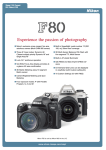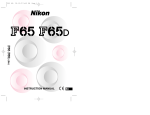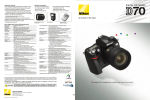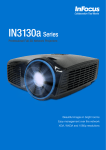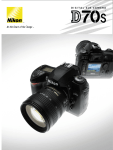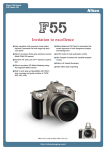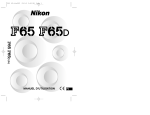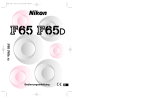Download Nikon N65 35mm SLR Camera
Transcript
FOR IMMEDIATE RELEASE Introducing the Nikon F65— a new camera for everyone offering the pedigree of Nikon SLR performance. Nikon Corporation is pleased to announce the introduction of the Nikon F65 35mm (135) format autofocus SLR camera designed for beginners to SLR photography. Offering SLR features and innovations that are standard in Nikon F5, F100 and F80 SLRs, Nikon system compatibility, and compact design, the F65 makes SLR photography very simple, convenient and versatile. Boasting an ergonomic design, the F65 features easy-to-use dials and a large LCD panel for simplicity of operation. The fully automatic AUTO mode, for example, offers point-and-shoot capability which is ideal for beginners to SLR photography. In addition, the F65’s Vari-Program modes handle specific subjects and scenes automatically—determining aperture and shutter speed values with the precision of a professional photographer. The F65 also features P, S, A and M exposure modes for control of exposure that grows along with the photographer’s capabilities. F65 advanced technology includes Nikon’s Five-Area Dynamic AF system with the Multi-CAM900 AF Sensor module used in the F80, sixsegment 3D Matrix Metering and built-in auto pop-up Speedlight with Matrix Balanced Fill-Flash. Moreover, the F65 operating system gives photographers complete control of the camera to create images as they like. The F65 offers photographers access to the Nikon System, which, includes the professional AF-S Nikkor lens lineup, the new AF VR Nikkor, and many other lenses, in addition to a range of accessories. The Nikon F65 is available in a standard and a QD version (F65D), both of which are available in black or silver colour. With its advanced features, simple operation and compact body design, the F65 is the ideal camera with which to gain entry to the world of fine SLR photography. 1 Feature Highlights Easy, intuitive operation For all its sophistication, the F65 is particularly easy and intuitive to operate, so photographers don’t require detailed technical knowledge to master desired photographic effects. Simply select a shooting mode according to the shooting situation or type of picture wanted. A built-in Speedlight automatically pops up, ready to illuminate a scene in low light. For optimal visibility, a large LCD panel with large characters makes it easy to set and monitor camera modes, and a dioptre adjustment function assures every photographer a clear look at the subject through the viewfinder. Five-Area Dynamic AF system with Multi-CAM900 AF Sensor module The Nikon F65 AF system features the F80’s Multi-CAM900 AF Sensor module. This module incorporates five-area AF sensors, including one centre-positioned cross-type sensor and four line sensors, positioned to the left, right, top and bottom, respectively, of the viewfinder frame. This unique array of AF sensors covers a wide area in horizontal and vertical coverage. Placement of the top and bottom sensors make cross-array AF sensing possible when shooting vertical compositions. 3D Matrix Metering The Matrix sensor in the Nikon F65 uses a six-segment metering sensor for improved metering results, even under complex lighting conditions. The camera provides 3D Matrix Metering when used with D-type or G-type AF Nikkor lenses. This metering system uses three types of data to provide accurate exposure: (1) scene brightness, (2) scene contrast and (3) subject distance. The scene brightness and contrast data are detected by the camera’s six-segment Matrix Sensor, while the distance information of the infocus subject is detected and relayed by the D-type or G-type AF Nikkor lens in use. The F65’s microcomputer analyses this data and makes the calculations necessary to assure correct exposure. 2 Matrix Balanced Fill-Flash With either the built-in Speedlight or Nikon dedicated Speedlight set at TTL, the user can take advantage of Matrix Balanced Fill-Flash. When used in low light, it automatically provides the correct illumination balance for the background and foreground. It can also be used in brightly lit scenes to fill in or eliminate shadows in backlit or high-contrast scenes. Matrix Balanced Fill-Flash is also useful for shooting in twilight and at night within a controlled shutter speed/aperture range. It operates with any auto exposure mode. Since each exposure mode has a different sync speed/aperture combination program, this gives the photographer broad creative latitude. Major Features Autofocus System • Multi-CAM 900 sensor—its five focus detection areas offer broad horizontal and vertical coverage • Two AF Area modes: Dynamic AF and Closest-subject-priority Dynamic AF • New Auto Servo AF determines whether the subject is stationary or moving, and chooses AF-S or AF-C operation • Unique overlap servo method makes autofocus fast and accurate • Nikon’s unique Lock-On™ autofocus operation • All AF sensors work with every AF Nikkor lens, regardless of its maximum aperture • Built-in AF-Assist Illuminator Exposure Metering System • 3D Matrix Metering: employs sophisticated algorithmic patterns and a database of more than 30,000 scenes of actual shooting data for exposure evaluation with six-segment Matrix sensor • Centre-Weighted Metering is selected in Manual exposure mode 3 Exposure Control • Comprehensive exposure modes: all-automatic AUTO mode, five VariProgram modes, and Auto-Multi Program, Shutter-Priority Auto, Aperture-Priority Auto and Manual modes • AUTO mode for convenient point-and-shoot operation • Vari-Program modes: Portrait, Landscape, Close-Up, Sports Continuous and Night Scene modes • Auto Exposure Bracketing—exposure bracketing of three frames in 0.5 to 2.0 EV steps available for all exposure modes including Manual • Exposure compensation—adjustable in 1/2 EV-step increments • Multiple exposure capability Built-in Speedlight and Advanced Flash System • Matrix Balanced Fill-Flash uses a built-in computer to provide automatic balanced exposure of the foreground subject and background scene • Built-in Speedlight automatically pops up when light is low in AUTO and Vari-Program modes • Coverage for lenses as wide as 28mm • Guide number of 12 (ISO 100, m) • Flash sync of 1/90 sec. • Slow Sync • Rear-Curtain Sync • Red-Eye Reduction Controls and accessories • Complete control at users’ fingertips -Large top-deck LCD panel -Command Dial -Mode Dial -Dioptre Adjustment (-1.5 to +0.8m-1) -Electronic depth-of-field preview button • The F65 delivers a film advance speed of approximately 2.5 fps with Sports Continuous mode. • Dedicated accessories -Battery Pack MB-17 (accepts four AA-type batteries) -Camera case CF-61 • Compatible with all AF Nikkor lenses 4 F65 Specifications Type of camera Integral-motor autofocus 35mm single-lens reflex with electronically controlled focal-plane shutter and built-in Speedlight Exposure modes a: AUTO mode Vari-Program modes (s: Portrait, d: Landscape, f: Close-Up, g: Sports Continuous, h: Night Scene) ¡: Auto-Multi Program (Flexible Program possible) ™: Shutter-Priority Auto £: Aperture-Priority Auto ¢: Manual Picture format 24 × 36mm (standard 35mm film format) Lens mount Nikon F mount (with AF coupling, AF contacts) Lens AF Nikkor and Ai-P Nikkor lenses (except AF Nikkor for F3AF and IX-Nikkor) Viewfinder Fixed eye-level pentaprism, built-in dioptre adjustment (–1.5 to +0.8m–1) Eyepoint 17mm (at –1.0m–1) Focusing screen B-type Clear Matte Screen V with focus brackets Viewfinder frame Approx. 89% coverage Finder magnification Approx. 0.68-0.60x with 50mm lens set to infinity (at –1.5 to +0.8m–1) Viewfinder information Focus indications, focus area, shutter speed, aperture, electronic analogue exposure display/exposure compensation value display, exposure compensation, ready-light/flash recommended/full flash output Five sets of focus brackets (area)/12mmø reference circle for CentreWeighted metering Reflex mirror Automatic, instant-return type Lens aperture Instant-return type, with depth-of-field preview button Autofocus TTL phase detection, Nikon Multi-CAM900 autofocus module with AF-Assist Illuminator (approx. 0.5m-3m) • Detection range: EV –1 to EV 19 (ISO 100, at normal temperature) Lens servo AF: Auto-Servo AF: camera automatically chooses Single Servo AF or Continuous Servo AF operation according to the subject status, i.e. stationary or moving (including directional information). • Single Servo AF (focus is locked when the subject is in focus) • Continuous Servo AF (camera continues to focus on a moving subject) Focus Tracking automatically activated in subject’s status ¢: Manual focus Focus area One of five focus areas can be selected 5 Focus Area mode • Dynamic AF Mode with Closest-Subject Priority • Dynamic AF Mode • Single Area Mode with ¢ (manual focus) Metering system TTL full-aperture exposure metering system Three metering systems selectable (limitations with lens used) • 3D six-segment Matrix Metering: with G- or D-type AF Nikkor • Six-segment Matrix Metering: with AF Nikkor other than G- or Dtype (except AF Nikkor for F3AF and IX-Nikkor), AI-P Nikkor • Centre-Weighted Metering: automatically selected with Manual exposure mode Metering range 3D Matrix Metering: EV 1-20 Centre-Weighted Metering: EV 1-20 (at normal temperature, ISO 100, f/1.4 lens) Exposure meter coupling CPU Exposure compensation Exposure compensated in ±2 EV range, in 1/2 steps (except in ¢ or a) Auto Exposure Bracketing Bracketing range: ±2 EV; number of shots: three; bracketing steps: 0.5, 1, 1.5 or 2 EV (except a or Vari-Program mode) Film speed setting • Automatically set to ISO film speed of DX-coded film in use (manual not selectable) • Film speed range: DX: ISO 25-5000, automatically set to ISO 100 with non-DX-coded film Shutter Electronically controlled vertical-travel focal-plane shutter Shutter speeds • In a, s, d, f, g, h, ¡, £: Automatically set between 30 and 1/2000 sec. • In ™: 30 to 1/2000 sec. (in 1/2 steps) • In ¢: 30 to 1/2000 sec. (in 1/2 steps), Time Sync contact X-contact only; flash synchronisation up to 1/90 sec. Built-in Speedlight • In a, s, d, f, g, h: Automatically activated • In ¡, ™, £, ¢: Activated by pressing flash lock-release button Guide number: 12 (at ISO 100, m); flash coverage: 28mm or longer lens; film speed range: ISO 25 to ISO 800 Flash control Controlled by TTL Sensor • Matrix Balanced Fill-Flash: Built-in Speedlight or optional Speedlight and CPU Nikkor lens (except in Manual exposure mode) • Standard TTL: In Manual exposure mode Flash sync mode Front-Curtain Sync (normal sync), Slow Sync, Rear-Curtain Sync, Red-Eye Reduction, Red-Eye Reduction with Slow Sync, Flash Cancel Ready-light • Flash fully charged: lights in green • Full output warning: blinks in green Flash recomended Blinks when the subject is dark or backlit and Speedlight is indication recommended in ¡, ™, £, and ¢ mode 6 Accessory shoe Standard ISO-type hot-shoe contact (sync contact, ready-light contact, TTL auto flash contact, monitor contact, GND), safety lock provided Self-timer Electronically controlled; timer duration: 10 sec. Remote control (optional) Infrared, activated by pressing the shutter release button; immediate release mode and 2 sec. delay mode; operating distance: approx. 5m directly in front of the camera; battery: one 3V CR2025 lithium battery; battery life: approx. 5 years (may differ with number of transmission or other operating conditions); dimensions: approx. 60 × 28 × 7mm (W × H × D); weight: approx. 10g including battery Depth-of-field preview button Stop-down lens aperture by pressing depth-of-field preview button; electronically controlled Film loading Film automatically advances to first frame when camera back is closed (shutter and reflection mirror not activated) Film advance • Automatic advance with built-in motor • Continuous shooting possible in g Sports Continuous mode (built-in Speedlight cannot be used) • Film advance speed: Approx. 2.5 fps (fresh batteries) Film rewind • Automatic rewind with built-in motor • Rewind speed with fresh batteries: Approx. 16 sec. with 36exposure film, Approx. 13 sec. with 24-exposure film Multiple exposure Selectable in ¡, ™, £, ¢ LCD panel information Shutter speed, aperture, exposure compensation, exposure compensation value, Auto Exposure Bracketing, Multiple exposure, flash sync mode, focus area, battery power, frame counter, self-timer, remote control Date/time imprint Built-in clock: 24-hour type with timing accuracy within ±90 function seconds a month; leap year adjustment until December 31, 2049 (F65D only) Usable film: ISO 32 to 3200 DX-coded film Display mode: Year/Month/Day, Day/Hour/Minute, No Imprint, Month/Day/Year and Day/Month/Year Power source: One 3V CR2025 lithium battery, battery life; approx. three years (depending upon use of data imprint function and other operating conditions) Camera back Hinged back with film confirmation window F65D: Data imprint LCD panel/buttons Power source Two 3V CR2 lithium batteries; optional Battery Pack MB-17 is also available (for four AA-type alkaline, lithium, NiCd or Ni-MH batteries) Power switch Power ON and OFF positions Exposure meter Auto meter shut-off 5 sec. after power turned on if no operations are performed; activated by lightly pressing shutter release button after power is turned on 7 Battery power confirmation In LCD panel, with exposure meter on • N for sufficient power • M indicates batteries are nearing exhaustion • Blinking M indicates batteries are just about exhausted Usable number of 36-exposure (24-exposure) film rolls per set of two fresh 3V lithium batteries Without flash With flash and AF-Assist Illuminator for half of all exposures At 20°C Approx. 50 (75) At –10°C Approx. 25 (37) Approx. 10 (15) Approx. 7 (10) Autofocus operation using an AF Zoom-Nikkor 28-80mm f/3.5-5.6D lens, covering the full range from infinity (∞) to the closest distance and back to infinity (∞) before each shot, with a shutter speed of 1/90 sec. or faster. Tripod socket Dimensions (W × H × D) 1/4 (diameter, JIS standard) F65: Approx. 139.5 × 92.5 × 65.5mm F65D: Approx. 139.5 × 92.5 × 68mm Weight F65: Approx. 395g (without batteries) F65D: Approx. 400g 8









